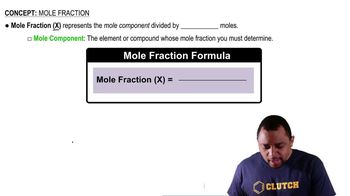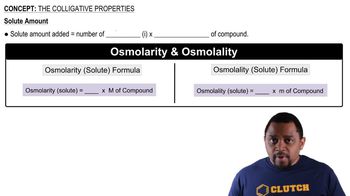Here are the essential concepts you must grasp in order to answer the question correctly.
Raoult's Law
Raoult's Law states that the vapor pressure of a solvent in a solution is directly proportional to the mole fraction of the solvent present. This principle is crucial for understanding how the addition of a solute, like ethylene glycol, affects the vapor pressure of a solvent, such as ethanol. By applying this law, one can calculate the change in vapor pressure when a non-volatile solute is added.
Recommended video:
Raoult's Law and Vapor Pressure
Mole Fraction
Mole fraction is a way of expressing the concentration of a component in a mixture, defined as the number of moles of that component divided by the total number of moles of all components. In this context, calculating the mole fraction of ethanol and ethylene glycol is essential to determine how much ethylene glycol needs to be added to achieve the desired reduction in vapor pressure.
Recommended video:
Colligative Properties
Colligative properties are properties of solutions that depend on the number of solute particles in a given amount of solvent, rather than the identity of the solute. Vapor pressure lowering is one such property, and understanding it helps in predicting how the addition of ethylene glycol will affect the vapor pressure of ethanol, allowing for the calculation of the required mass of solute.
Recommended video:




